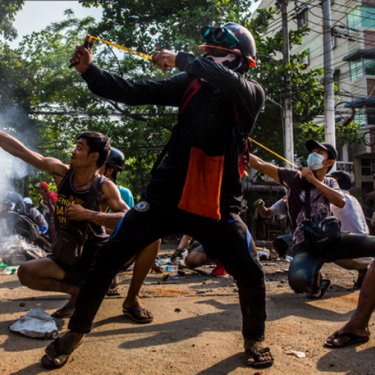“The courage and struggle of Myanmar’s reporters must not be forgotten”

Eight months to the day after the military coup in Myanmar on 1 February, Reporters Without Borders (RSF) is providing an update on the terror to which reporters in the field are being subjected, along with video testimony by one of the heroic reporters who, despite all the danger, is still covering this story.
In the space of eight months, Myanmar’s military have succeeded in overtaking the Saudi and North Korean dictatorships in the ranking of the world’s biggest jailers of journalists. Only China now detains more journalists than Myanmar.
According to RSF’s tally, of the approximately 100 professional journalists arrested in the course of the past eight months in Myanmar, at least 53 are still in prison. Two non-professional journalists and a media worker are also still imprisoned.
Eighty-five percent of these journalists worked in the field as reporters, photographers or video reporters and three quarters of them were arrested more than four months ago. This confirms an observation first made in June, namely, that most of the detainees were arrested while covering the massive street protests that took place during the first four months after the coup.
Persecution
After the military terror finally proved effective, protesters and journalists were forced to go into hiding during the course of the summer. But clandestinity has not always spared them from persecution. As RSF reported in August and again in September, the five journalists arrested in the past two months were “tracked down” by the security forces and were caught in the places where they were hiding.
“In eight months, the military junta has succeeded in paralysing the situation to the point that the international community is now largely ignoring the drama that continues to unfold in Myanmar,” said Daniel Bastard, the head of RSF’s Asia-Pacific desk. “As they must now elude the military’s increasingly ferocious persecution, the reporting provided by journalists in the field is all the more valuable. Their stories, their courage and their struggle must not be forgotten.”
RSF recently met one of Myanmar’s heroic reporters, who prefers to remain anonymous for safety reasons. A photo-journalist for the past decade, he was awarded a prize last month at the 2021 Visa pour l’Image festival in Perpignan, in southern France, for his coverage of the “spring revolution,” much of which was published in the New York Times.
Easier target
“On the morning of 1 February, I woke up with a call from my colleague saying there’s been a coup. Suddenly, I wasn’t sure whether we could work as journalists anymore. In the first few weeks of February, it was okay for us to photograph the protests, to get close to the security forces. But when the crackdown actually started, it became clear there was no place for journalists.”
A reporter’s job now included not being injured or arrested. “During the crackdown on the protests, they would harass and beat journalists, so we really had to be careful where we went, when they came. There was tear gas, sound grenades, rubber bullets. But very often there were live bullets as well. A journalist I know in Mandalay lost his hand after he was shot while he was working.”
He discovered the need to keep a low profile. “We were also very confused, we didn’t know if we should wear press logos and helmets as well. Because when you are wearing this, you become an easier target. It’s very hard to tell because you can go out and not come back or you can go out and be injured, be hospitalised… Or you can be just killed.”
Myanmar is currently ranked 140th out of 180 countries in RSF's World Press Freedom Index.



